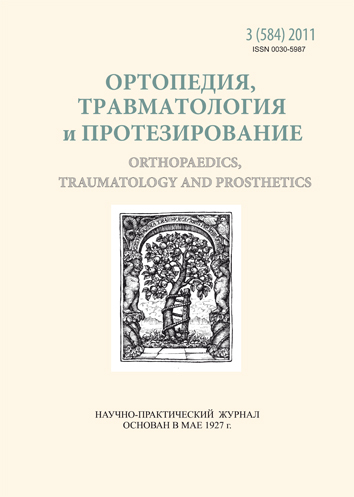Location of fragments in Pilon fractures and choice of the way for their repositioning and holding
DOI:
https://doi.org/10.15674/0030-598720113111-116Keywords:
fractures pilon, classification, reduction, traction, fixation with devicesAbstract
Pilon fractures are isolated in a separate group, which unites some similar signs: these fractures result from an axial load and their location is epimetaphyseal, fracture planes passing through the articular area of the tibia. The choice of the method of reduction and fixing of fragments in such compound and multiform fractures should be based on detailed knowledge of their configuration, mechanical cooperation as well as on the prognostic assessment of residual deformities. The work is based on experience of treating 51 casualties with fractures of the distal epimetaphysis of crural bones at the age from 18 to 80 years. It is shown that in pilon fractures of 43 B type the reposition of fragments by traction is effective, when the free tibial fragment is located on the anterointernal or posterointernal part of the epimetaphysis. If the fragment is located on the external part of the epimetaphysis and combined with a fibial fracture, an attempt to reduce it by traction is more often ineffective. In pilon fractures of43 Ctype it is possible to isolate the main fragment, which includes the largest part of the articular surface. Traction reposition of fragments in such a type of fractures was achieved in one third of patients with a small value of displacement. It is advisable to use close traction reposition (by traction or with a device) as the first stage, thereby making it possible to reduce the main fragments and reveal those ones, which are to be reduced in an open way. The above thing makes it possible to operate selectively and with little traumatism.
References
- An update on the management of high-energy pilon fractures / I.S. Tarkin, M.P. Clare, A. Marcantonio, H.C. Pape // Injury. — 2008. — Vol. 39, Issue 2. — P. 142–154.
- Fixation of tibial pilon fractures with percutaneous cannulated screws / Mujahid Ali Syed, Vinod Kumar Panchbhavi // Injury. — 2004. — Vol. 35, Issue 3. — P. 284–289.
- Оперативное лечение около- внутрисуставных переломов дистального отдела костей голени / А.Н. Побел, И.Л. Пелещук., Т.А. Амро и др. // Ортопед. травматол. — 2003. — № 3. — С. 59–62. — ISSN 0030-5987.
- Современные подходы к лечению внутрисуставных переломов и переломо-вывихов в области голеностопного сустава аппаратами внешней фиксации / В.Н. Пастернак, В.Ю. Черныш, А.Я. Лобко и др. // Ортопед., травматол. — 2004. — № 1. — С. 13–15.
- Nikolaou Minimally invasive plate osteosynthesis — an update / S. Vassilios, N. Efstathopoulos, C. Papakostidis at al. // Current Orthopaedics. — 2008. — Vol. 22, Issue 3. — P. 202–207.
- Pilon fractures of the tibia / P. de Boer, R. Metcalfe // Current Orthopaedics. — 2003. — Vol. 17, Issue 3. — P. 190–199.
- Foot and Ankle hyperbook. Pilon fractures classification [Элекстрон. ресурс]. — Режим доступа к интернет-ресурсу: http://www.foothyperbook.com/trauma/pilonFx/ PilonFracturesClassn.html.
- A retrospective analysis of commuinuted intra-articular fractures of the tibial plafond: Open reduction and internal fixation versus external Ilizarov fixation / S. Bacon, W.R. Smith, S.J. Morgan et al. // Injury. — 2008. — Vol. 39, Issue 2. — P. 196–202.
Downloads
How to Cite
Issue
Section
License
Copyright (c) 2014 Anatoliy Pobel, Ivan Trufanov, Volodymyr Gatsak

This work is licensed under a Creative Commons Attribution 4.0 International License.
The authors retain the right of authorship of their manuscript and pass the journal the right of the first publication of this article, which automatically become available from the date of publication under the terms of Creative Commons Attribution License, which allows others to freely distribute the published manuscript with mandatory linking to authors of the original research and the first publication of this one in this journal.
Authors have the right to enter into a separate supplemental agreement on the additional non-exclusive distribution of manuscript in the form in which it was published by the journal (i.e. to put work in electronic storage of an institution or publish as a part of the book) while maintaining the reference to the first publication of the manuscript in this journal.
The editorial policy of the journal allows authors and encourages manuscript accommodation online (i.e. in storage of an institution or on the personal websites) as before submission of the manuscript to the editorial office, and during its editorial processing because it contributes to productive scientific discussion and positively affects the efficiency and dynamics of the published manuscript citation (see The Effect of Open Access).














